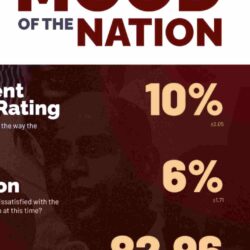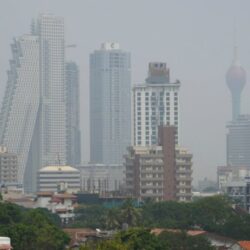Published in The Island
The real question is not whether Sri Lanka should go to the IMF or not. What is important is going to the IMF with confidence after having analysed the fiscal situation, with a convincing plan, Executive Director of Verité Research Dr. Nishan de Mel said in Colombo recently.
He made this remark at a CEOs Forum hosted by CA Sri Lanka to provide clarity on the current debt situation, whilst also helping the business community gain a better understanding on the government’s strategy and way forward to navigate through the ongoing situation.
State Minister of Money and Capital Market and State Enterprise Reforms Ajith Nivard Cabraal, was the guest speaker and the panel session brought together eminent speakers comprising of Governor of the Central Bank of Sri Lanka Professor W. D. Lakshman, Chairman of the Ceylon Chamber of Commerce Vish Govindasamy, [Executive Director of Verité Research (Pvt) Ltd Dr. Nishan de Mel], and Managing Director of Fitch Rating Agency Maninda Wickramasinghe.
Dr. Nishan de Mel further said: “For instance, when you go to a bank with a business idea to take out a loan, the bank says, ‘give me your plan’. But if you get the credit officer to write the plan for you it won’t be appropriate. The mistake Sri Lanka makes is letting the IMF write that plan for the country because the country doesn’t have one. The crux of the matter is; the credit officer shouldn’t write the plan. The country should present the plan and convince the credit officer that the plan has the potential to work out – a plan backed by an analysis that can win the confidence of the lender. That’s the structured way to obtain an IMF facility for Sri Lanka. I do hope that we can take that path.”
“The Central Bank may have a different approach to analyzsng the situation – I think publishing that analysis would be very valid because that is a test of some scrutiny and others would be able to look at it – that is a way to give confidence. I completely accept that there is no one way to analyse the situation and determine the approaches we can take, but it is important to make the chosen approach public.”
“The government and the Central Bank of Sri Lanka (CBSL) are on the right path with regard to reducing the ratio of foreign debt to domestic debt, but the greater reliance placed on domestic financing too quickly would be like running a marathon too fast as it could burn out the accelerated shift.”
“On the other hand, we might not have the option of being too slow on this aspect as rating agencies are downgrading and the markets are observing. Amid this we have to build confidence. These are very concerning which is why I say it is not too late for Sri Lanka to realign its strategy to get out of the problem and to keep its debt sustainable while making sure we won’t run into a liquidity crisis.”
“Verité’s own analysis shows that there are four steps that can make debt repayment more sustainable and a fifth step to avoid a reserve crisis which people are worried about.”
“Number 1; the interest rates on local debt can be no higher than inflation which I think we have probably achieved. The Central Bank has had a larger tolerance for inflation and it will end up in 6.5% range, and interest rates on local debt have been brought down which is an important part of the function. I t will take some time for all the government debt to reflect that lower rate, but that in reality is the right path. However, it’s a cost to society because inflation is costly in terms of real returns from your bank balances or investments.”
“Secondly, interest rates on foreign denominated loans can’t be higher than GDP growth There also Sri Lanka is well placed because even though we talk about having a large amount of commercial debt, the history of concessional debt is so high that our weighted average interest rate on foreign denominated debt is still only 3.9%, and going forward with a growth of about 4%, we can maintain that. Being able to maintain the interest on that percentage rate for foreign denominated loans is favourable for Sri Lanka.”
“Then there are two other conditions that Sri Lanka needs to do more about. One is the primary deficit- that is the deficit after paying interest- which should be less than 60% of GDP growth – that means if the GDP growth is 5%, primary deficit can’t be more than 3%. If we are expecting a lower GDP growth this time; say a growth of 3.3%, then the primary deficit can’t be more than 3%. So we really have to control that and bring it down. And it is very important to report those numbers correctly to give the markets that confidence. This still allows for a budget deficit in the high single digits because our total interest on debt is over 6% of GDP. This is not drastic, but it says that deficit has to be in the mid single digits. If we want to maintain the deficit, we need to be able to manage the upper single digits with a doable plan.”
The fourth is that depreciation of the currency can be no higher than inflation, and that brings us to the fifth step because currency depreciation today is not based on the fundamental mismatch in global crisis vs Sri Lankan crisis. From 2015 to 2019, one of the major important adjustments made was, to bring it to what you call the real exchange rate. Sri Lanka’s exchange rate until 2015 was significantly over valued. Even though depreciation hurt, the adjustment brought stability. That was an important alignment. That alignment is still sort of in place but today because of the uncertainty about the reserves, you see a speculative exchange rate- and that simply puts pressure on depreciation.”, he said.
Last modified: April 1, 2024












